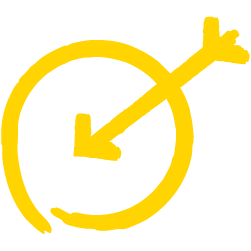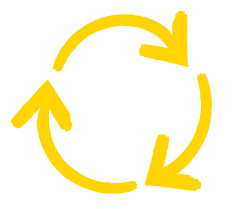We know that long term social change takes time. When planning your advocacy, it is important to keep sight of the longer term structural change you are trying to achieve.
However, it is also important to be realistic about what you can achieve in the short and medium term depending on your context, resources and existing relationships.
At the Y we don’t need to reinvent the wheel and we highly recommend the Plan model taken from Womankind’s Plan Your Power Toolkit.
Skip to a step:
Transforming your issue into an objective
Power mapping – targets and allies
Agreeing on strategic approaches
Identifying Risk and How to Manage It
Choosing your advocacy activities
Power Analysis and Context
In order to challenge unequal power relations and structures, we need to identify and understand the existing forms and expressions of power to tackle the root causes, not just the ‘symptoms’ of inequality. A power analysis can help you to work out who has the power to help you and what your own level of power is. This tells you who you need to be talking to or working with and might also tell you what actions you need to take in your advocacy.
If you have time constraints, be careful not to spend too much time on context mapping or you may run out of time for the strategic decision making later. In a workshop setting, workshop participants may be able to do some pre-reading to inform this stage of the process. If you discover you have evidence gaps that you need to fill in order to understand your context, consider how you can find out what you need to know. You may need to undertake further research, interview power holders or communities most affected by the problem or take some time to discuss the issue with community organisations.
Many of the traditional tools used for context power analysis focus on oppressive forms of power, such as formal decision-making power and access to resources. While this analysis is important, it is equally important to think about transformative power – including your power as individuals, staff and as members of a coalition, network or alliance.
Power check
- How does your own power impact on the context in which your advocacy is taking place?
- How are you creating space for the perspectives, skills and experiences of women, in all their diversity, to be included in your analysis?
- What relationships and knowledge do you already have on this issue within your own or partner organisations? How can you share and build on this?
Consider power in social, economic, political and cultural spheres and the relevant processes you might be trying to influence. Understanding these processes is important so that you can think about the most strategic points for engagement.
For example, if you are trying to influence a decision-making process, such as the passage of new legislation through parliament or a community development planning and budgeting process, you may find it useful to map out the stages of this process and identify the points at which key decisions will be taken.
Transforming Your Issue into an Objective
Advocacy objectives are the changes which need to be made in order to address your issue. You should have between one to three objectives for each advocacy planning cycle.
First spend time working out what the specific issue is that you are trying to change. Try and summarise it in one sentence e.g. “Abortion is legal but restricted in South Australia” or “Universities are not doing enough to prevent sexual harassment” or “Government paid parental leave is inadequate”. It can be useful to break your process down into steps:

Step 1
Identify your issue and your endgame (e.g. Problem = climate change, End Game = a sustainable planet).

Step 2
Is there another step here in breaking down the large issue into smaller addressable objectives E.g. Problem = gender inequality, End Game = women live free from violence, small steps = funding for legal clinics, national primary prevention programs, parental leave.

Step 3
Draft objectives by brainstorming ways to address the issue with your group. Make sure your objective is tangible (e.g. what policy are you seeking to change? What program do you want funded?).

Step 4
Remember to consult with those most impacted by the issue, and if you can’t speak to people directly, perhaps someone has done research on the issue that you can reference. For example, there are studies where researchers have spoken with university student victim survivors of sexual assault.

Step 6
Prioritise your objectives.
Power mapping – targets and allies
Having identified the change you want to see, we now need to look at who has the power to achieve your objectives, who stands in the way and who you could build relationships with to help you.
This stage of the advocacy planning process focuses on two key steps. Firstly, you need to identify who your advocacy targets (power holders and influencers) and allies are, and secondly, you need to understand as much about them as possible. This will inform exactly what you will do (your strategic approach) in the next section. Find out who you can speak to about your issue.
Understanding your own power, connections and levers for influence is a great activity to brainstorm with others
- Who are your people/community/allies? What makes your people impactful or unique?
- What skills do you have (e.g. social media, online campaigning, film-making, sports etc.)
- Do you have lived experience of this issue?
- Does your group have any personal connections with people of influence? Who are your local representatives? Are you in a marginal electorate?
Researching Parliamentarians’ First Speeches
Politicians use their first speech to indicate the issues that closely affect them and are of significance to their constituency. This is a great starting point when researching your politician and can help you frame your issue for maximum relevance to their electorate. First speeches may be found on parliamentarian profile pages on the Parliament House website.
Voting History
The majority of votes on legislation will reflect the collective position of the party to which a member belongs. Considering a politician’s voting history can give a fairly reliable indication of their party’s platform. In the case of the crossbench, voting histories can be helpful in directing you to which members you should work with or work on. This data is available at the TheyVoteForYou and OpenAustralia websites.
Other Materials
Hansard provides an online written record of parliamentary proceedings. You can use this to get a sense of what a politician has been willing to speak about in the past. Media reports and social media profiles can also provide up-to-date information on their interests and activity. Being able to discuss what your politician is passionate about shows that you have invested some effort in finding out what they stand for.
Committee Membership
Your politician will be a member of various policy committees. Knowing what committees they are on will help you understand their interests and networks. This
information is readily available on parliamentarian profile pages on the Parliament House website.
Party Platforms
Unless you are approaching an independent, your target for advocacy will have made a commitment to support their party’s policies and platform, so check these out and shape your ask accordingly. Even if a politician can’t publicly advocate for your position, they may be able to give an insight into the kinds of conditions under which their party would consider changing their position.
Agreeing on strategic approaches
The kinds of strategies you use will reflect your strengths and values. You might use mostly insider or outsider strategies. ‘Insider’ refers to working inside the system (such as official policy spaces and processes) and ‘outsider’ refers to working outside of these official spaces and processes to pressure for change.
Insider strategies can be efficient but pose the danger of co-option* and may be less effective in building transformative power as they tend to operate within existing power structures. On the other hand, outsider strategies can alienate targets and exclude you from future access. A mixture of both can be effective, especially in an alliance, but it’s then important to ensure that everyone respects each other’s methods.
In addition to any specific objective on movement-building, it is also important in gender equality advocacy to ensure that building transformative power is integral to all advocacy strategies.
Co-option
Co-option refers to the process of adding members to an elite group at the discretion of members of the body, usually to manage opposition and maintain the stability of the group. Outsiders are ‘co-opted’ by being given
a degree of power on the grounds of their elite status, specialist knowledge, or potential ability to threaten essential commitments or goals. Informally speaking, it’s a form of manipulation.
When is the best time to advocate?
There is no time like now [#TimesUp] but lots of advocacy can occur in cycles, for example at Federal or State Budget time, or when a new bill is up for debate, it can occur on an International Day of XXX or after an incident has occurred and an issue is in the news cycle already.
At YWCA, we differentiate types of advocacy by their drivers. We call them Advocacy Activation Points, things we know are happening ahead of time like International Day of Violence Against Women and Advocacy Activation Opportunities, things that we can react to as they present.
They can be trigger events such as the death of a young woman at the hands of a violent male partner, an investigative journalism piece that sparks social conversation and more often than not examples of everyday stereotypes and/or discrimination played out in
popular culture—a Prime Minister talking over a female minister at a press conference or a high kick photograph of a women’s AFL player. It can be hard to find perfect timing but the opportunities are endless.
It can be really useful to understand the processes of Federal and State parliaments and to work out if there is an opportunity to build on that momentum with your advocacy. It can also be useful to look at sitting days and work out when MPs are more likely to be in their electorate and more available to meet or talk. During unprecedented times such as natural disasters like bushfires or drought or during global pandemics it can be even more difficult to time your advocacy and it is always useful to look for alternative ways to advocate such as targeting MPs on social media or at events held to canvass the local community.
Identifying Risk and How to Manage It
You will have noticed in the advocacy plan diagram above that ‘Identifying Risk and How to Manage It’ crosses over all steps of the advocacy process.
Always consider the possible risks and develop a contingency plan for every action. Problems are always easier to manage when you’ve prepared for them, and sometimes you can avoid them altogether. Good luck!

STEP 1: Identify the risk
You and anyone you are working on this with will uncover, recognise and describe risks that might affect your project or its outcomes. Create a risk register table to keep a record, you will review this in step 5.

STEP 2: Analyse the risk
Once risks are identified, you determine the likelihood and consequence of each risk. You develop an understanding of the
nature of the risk and its potential to affect project goals and objectives.
Add it to the risk register.

STEP 3: Evaluate or rank the risk.
You evaluate or rank the risk by determining the risk magnitude, which is the combination of likelihood and consequence. You make decisions about whether the risk is acceptable or whether it is serious enough to warrant treatment.
Add it to the risk register.

STEP 4: Treat the risk.
During this step you assess your highest ranked risks and set out a plan to treat or modify these risks to achieve acceptable risk levels. How can you minimise the probability of the negative risks as well as enhancing the opportunities? You create risk mitigation strategies, preventive plans and contingency plans in this step.
Add it to the risk register.

STEP 5: Monitor and review the risk.
This is the step where you monitor, track and review risks in the risk register. A risk register should be a regularly updated document— make it a standing agenda item in any planning meetings you have on this issue.
Choosing your Advocacy Activities
Now you have identified your priority strategies and outcomes, the next step is
to plan the activities which will help you achieve your outcomes.
Don’t choose an activity just because it may have worked for others before, make sure that it is a strategic way of achieving your desired outcome. Also, check that your
activities meet your longer-term ambitions. To do this, you can ask yourself two questions: 1. what are the things which need to change to achieve the outcome
we want? and 2. what actions would cause that change?
It is important to prioritise activities and check whether they are realistic and achievable. Consider:
- Do you have the necessary capacity, resources or money for a particular activity?
- Are the timeframes achievable or do you have multiple activities taking place at the same time?
- Who will lead, support and contribute to the activities? Identifying who is responsible is really important for ensuring an activity happens.
- Is the leadership shared and does it reflect the intersectional nature of the discrimination people face?
- Are you considering risks and the mitigating actions that might be necessary?
Advocacy Activity Examples

Research
- Desktop research and analysis of existing information points.
- Collaborating with someone to write a research paper and/or develop advocacy materials.
- Undertaking research projects using an intersectional approach.
- Partnering with research institutions, such as a university.
- Providing technical and advisory support to power holders.
- Presenting at conferences and/or creating space for diverse voices in public forums.
- Piloting new approaches and sharing learning.

Direct influencing of parliamentarians
- Sharing information with allies and the wider movement.
- Briefings or letters.
- Attending events and opening space for under-represented people to attend.
- Inclusive input into existing consultation processes.
- Attending regional and international policy forums as a group which includes under-represented people.

Activism (including campaigning and public outreach)
- Campaign materials with key messages.
- Community-led marches, events and community forums.
- Public actions such as petitions and pledges.
- Media engagement (including social media and digital campaigning).
- Tools and training to support community and workplace activism.
- Convening spaces (such as gender equality forums) to connect with voters.
- Fostering connections across movements by sharing knowledge and tools and opening space.
- Creative campaigns
- Collective care and reflection debriefings.
- Engagement with creative industries such as artists, sculptors, street-art artists, graphic designers.
Developing key messages
Communicating your ideas effectively is essential for advocacy. A campaign works best when the key messages are repeated.
You may become bored with them, but your target audience needs to hear it several times before it has impact.
Well-developed key messages are an important way of ensuring that all your different advocacy activities are directed towards your agreed objective. It is essential that your key message accurately reflects what you are trying to achieve with your advocacy, with your targets and strategy in mind.
Once you have your key message, you can tailor and adapt this for different audiences. The tone, length and style you use will depend on the audience, but the basic message should remain the same.
Each message should include what, when, why and how to act. It should capture people’s attention and persuade them of the argument, without overwhelming them with too much information.
Tailoring your key message
It is a good idea to develop different framing of messages for audiences such as the media and the general public. You could think about developing a slogan and a hashtag. For this you need a message that’s emotive, eye-catching and that will inspire people to act. Think about what each of these audiences might be interested in and focus on this. Just make sure your messages are all saying the same thing and supporting your long term aim—just framed in different ways.
Key message example
The Climate Crisis is an issue that impacts all of us, but the burden is not equal. Women & girls are generally the most impacted when it comes to natural disasters, and this only gets more complex when also considering the added intersections of: race, geographic location, financial income, disability or chronic health issues, family caring responsibilities and so on.
On the flip side of this, many of the solutions to address the climate crisis are connected to empowering women. This includes everything from creating addressing financial inequality, childcare, accessibility needs included in emergency responses, to having access to education, power in making decisions on every level of government.
Communicating your messages
Having agreed on your key message you will need to think about how to communicate it, and what channels you will use.
The earlier work you did on understanding your targets will have revealed who they listen to, which may give you ideas. Combine this with the existing knowledge and contacts you have, such as in local or national media.
Think about using social media too. Make sure though that you focus on the communication channels that actually influence your targets—not just the ones that appeal to you.
This article is from our Y Advocacy Toolkit, a collection of practical tips and advice navigating advocacy in Australia will help you to identify policy areas of particular interest to you, and who you can talk to about creating change. Want to get more involved in advocacy but don’t know where to start? Why not join our Cyber Feminists (CBF)?





